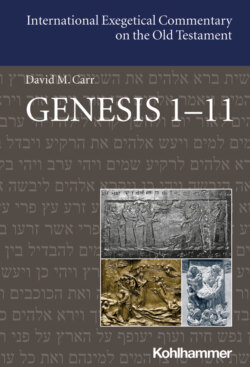Читать книгу Genesis 1-11 - David M. Carr - Страница 23
The Question of Stratification within Gen 1:1–2:3 Itself
ОглавлениеOne final place to ask diachronic questions is exploration of the possibility that we might reconstruct within Gen 1:1–2:3 itself embedded precursor texts, whether in the form of sources or earlier oral or written traditions distinguished from later reshaping and/or redaction. From the late 1700’s onward, scholars have thought it possible to identify later additions to the chapter.
The most plausible theory proposed so far is the earliest one. Already in the late 1700’s, several scholars (Ziegler, Gabler, and Ilgen) argued that the theme of the Sabbath in 2:2–3 had been added secondarily to the creation narrative that preceded it.32 There were two main grounds for this theory—their intuition that the style of the seventh day narration diverged from that of the preceding chapter, and their belief that the distribution of eight creation acts over six days in Gen 1:3–31 is a secondary adaptation of an earlier account to the present seven-day structure. This theory has gained many adherents in subsequent years and a few new arguments. For example, in 1877 Wellhausen found it problematic that day and night were said to alternate from day one, even though the sun and other heavenly bodies that would enable such alternation are not created until day four.33 Furthermore, Westermann noted that the closest parallels between Gen 1 and its probable Enuma Elish epic precursor begin after the problematic creation of light on day one, with the creation of a plate divider on Gen 1:6–8 that parallels Marduk’s splitting of upper and lower oceans with Tiamat’s carcass (IV:137–38). This led Westermann to follow an earlier 1939 study by May, that posited a secondary Sabbath layer in Gen 1:1–2:3 that included the first day in 1:3–5, the broader day structure it enables (Gen 1:5b, 8b, 13, 19, 23, 31b) and God’s rest on the seventh day in 2:2–3.34
The following close reading of Gen 1:1–2:3 could provide some additional grounds for taking this theory seriously. For example, towards the conclusion we will see how the text preserves competing structural frameworks, one that connects to the broader Sabbath theme of the present chapter (a balance of 3+3 days) and one that does not. Nevertheless, some ongoing problems with the theory of a secondary Sabbath redaction of Gen 1 render this theory too speculative to form the basis for synchronic commentary.35 As we will see, the present form of the description of creation of heavenly bodies in Gen 1:14–18 seems shaped to account for how day and night might be distinguished in the wake of the intervening creation of the heavenly plate (Gen 1:6–8). In addition, a good argument can be made that the motif of God’s Sabbath rest in Gen 2:2–3 is the Gen 1 counterpart to the rest of the gods featured at multiple points in the Enuma Elish epic.36
Theories of Word and Act Sources or Strata in Gen 1
It should be emphasized that there are fewer indicators in Gen 1 to point to the reconstruction of “word” and “act” sources of the kind posited initially by Schwally in a 1904 lecture in Giessen (published in 1906) and then published by his former professor in Giessen, Stade, in 1905,37 and there are even more serious problems with the more recent modification of this theory into “word” or “act” compositional layers.38 These approaches are first of all founded on a fundamental misunderstanding of the nature of the above-discussed correspondence formula as an independent statement, an understanding initially refuted in responses from Jacob and Humbert.39 Second, they over-read and misunderstand slight differences in formulation between the divine creation speeches and creation events, differences that the text itself bridges with regular correspondence formulae and statements of divine approval. Third, as Steck points out, more recent redactional approaches differentiating a later “act” or (more often) “word” layer fail to capitalize on the argument of doubling between act and word reports that was so crucial to Stade and Schwally’s initial proposals of parallel sources, and they fail to explain why an “act” or “word” redactor would have so carefully preserved an earlier source whose perspective they felt so compelled to correct.40
